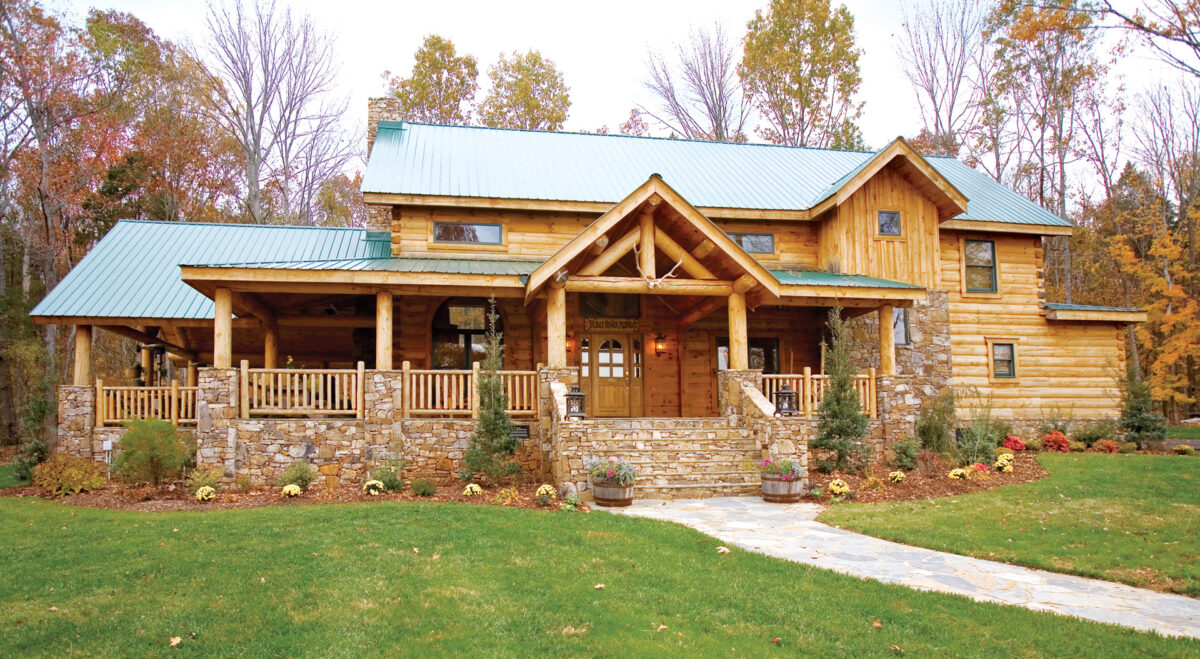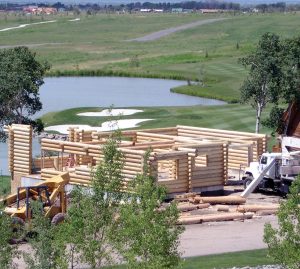Making your dream home a reality is a step-by-step process.
More people are opting to live in rustic residences than ever before. The warmth of wood, the solid construction, and that powerful connection to nature all add up to a feeling of safety and sanctuary that we crave in today’s uncertain world.
Here are seven strategies to make your project go smoothly.
Step One: Establish a Budget
Dial in your finances before evaluating designs or comparing log and timber home companies. This will save you time and heartache, because you don’t want to design a home that you can’t afford to build.
If you’re selling your current home to finance the new home, meet with an agent to determine its value and the best time of year to sell. Once you decide to sell, it’s no longer a home. It’s a commodity that you want to get the most money for.
Step Two: Locate Land
The real estate adage—location, location, location—still holds true. It’s the most important part of the equation. Start by shopping online. Once you’ve found possibilities, visit the local building department’s website (either city or county) to research the rules. This will help you understand past, present, and future use.
When shopping for land, consider the following:
- If using city services, how much are “tap fees,” to tap into water and sewer?
- If you are installing a well and septic system, you will have to pass a “perc” or percolation test.
- How much are local taxes?
- Is medical care accessible?
- Will your site be in a convenant-controlled community with a homeowner’s association?
After finding a likely lot, work out a contingency agreement with the seller. Your deposit (usually nonrefundable) gives you 30 to 90 days to determine if the site is buildable.
Step Three: Shop for a Lender
In the early 2000s, large banks deemed construction loans too risky, so they stopped offering them. If you will need to finance construction, start seeking out smaller banks and credit unions, especially those that offer one-close, construction-perm loans.
What will you need to shop for a lender?
- A 700+ credit score is ideal
- Two years of W2s, 1099s, and full 1040 (federal, not state) forms, both personal and business, plus a K-1 form (if applicable)
- Thirty days of paystubs or monthly pension advisements
- Your Social Security or pension award letter
- Two months of complete bank statements for all accounts and investments
- A mortgage statement for your current home and any additional properties you own
- A contract for the land on which you intend to build
Most lenders will allow a 43 percent total debt to income ratio. Some offer more than 43 percent, provided you have higher amounts of discretionary income.
Step Four: Design Your Dream Home
As you peruse designs, start to ask yourself some basic questions.
- What kind of design will fit with the topography of the building site?
- What type of design: single-story ranch, 1.5 story, split-level, two-story?
- Will the new home have a basement or crawl space? Or will it be built on piers or a slab?
- How much square footage is needed?
- How many bedrooms?
- How many baths?
- Are any special areas needed for hobbies or toys?
- How about a home theater, a custom kitchen, or exercise room?
- How much storage space is needed?
Step Five: Choosing a Log and Timber Home Producer
Many home buyers think that finding a producer near their building site will save a lot of money on transportation costs. Even if you’re building cross-country from your producer, the cost of transportation would be less than one percent of the budget. If you need to reduce costs, focus on the other 99 percent of the budget.
Other buyers set out to discover who has the best building system. The truth is there isn’t a best building system. If there were, every company would be using the same one. Our advice is to have those that offer your favorite building style bid on your project.
Before money changes hands, ensure that you: (1) have an attorney review all contracts; (2) know the moisture content of a producer’s logs and timbers, since this affects a host of issues; (3) understand how the company’s building system accounts for the settlement of logs and timbers; (4) obtain all payment policies.
Step Six: Choosing a Builder
Most log and timber companies leave it to independent builders or contractors to complete the home on your land. The goal is to have at least three contractors bid on your project, then evaluate each bid closely.
Before entering into a contract with the builder, make sure you: (1) check references; (2) tour completed homes; (3) check with the state’s attorney general’s office for any complaints against the builder; (4) verify the builder is licensed and insured for your location.
Step Seven: Finalizing Your Loan
To close on your loan, lenders will want to know exactly what you’re going to build, how much it will cost, how long it will take, and who’ll be doing the work. Here’s what you will need to provide: (1) building permits; (2) contract with your log and timber home company specifying all materials; (3) construction drawings; (4) contract with a contractor; (5) survey or plot plan; (6) land deed showing the title and mortgage information.
Once the loan is granted, the lender disburses the money according to a draw schedule, which is typically five or six disbursements. Progress is verified by on-site inspections.
Your log and timber home producer will require payment before cutting and shipping the logs or timber frame. Don’t enter this contract or make payment for your log and timber frame package until you’ve secured a construction loan.
Another challenge when financing is the appraisal process. Appraisers need comparable sales, or “comps.” At issue is what ultimately happens to your mortgage loan. Some lenders will keep a mortgage in its portfolio. Others sell the mortgage on the open market or to Fannie Mae (the Federal National Mortgage Association). If selling, the loan will need to conform to certain guidelines, which may require more money from you to finalize the loan.
Start by informing your appraiser that log and timber homes need not be compared to other log and timber homes. They should be compared to other custom homes recently sold, as per the Fannie Mae FAQ #25 and #26.
Following these steps will ensure you’re in your new log and timber home and making memories that will last a lifetime. Thousands have made the same journey. Invariably their only regret? They should have done it sooner.


